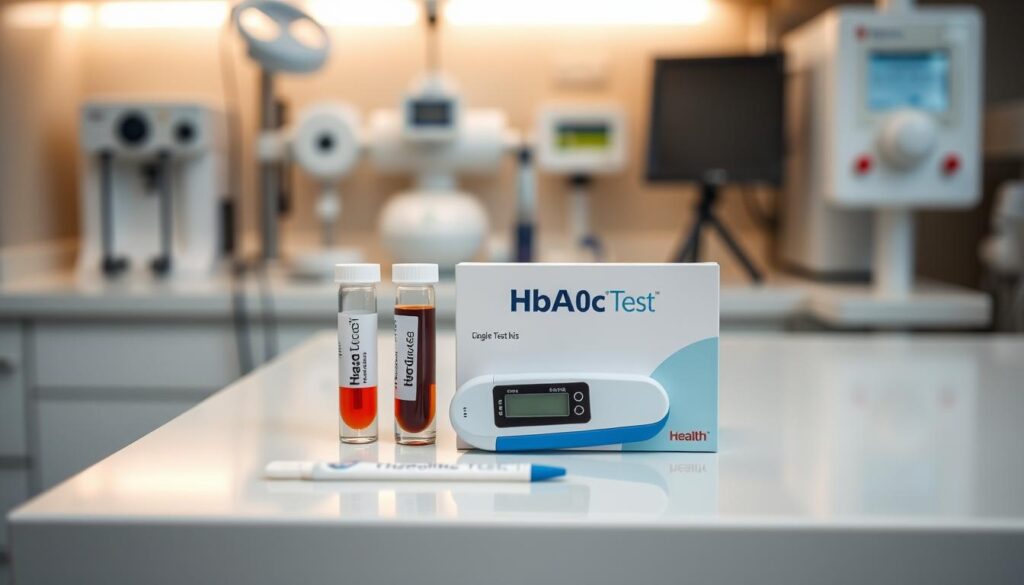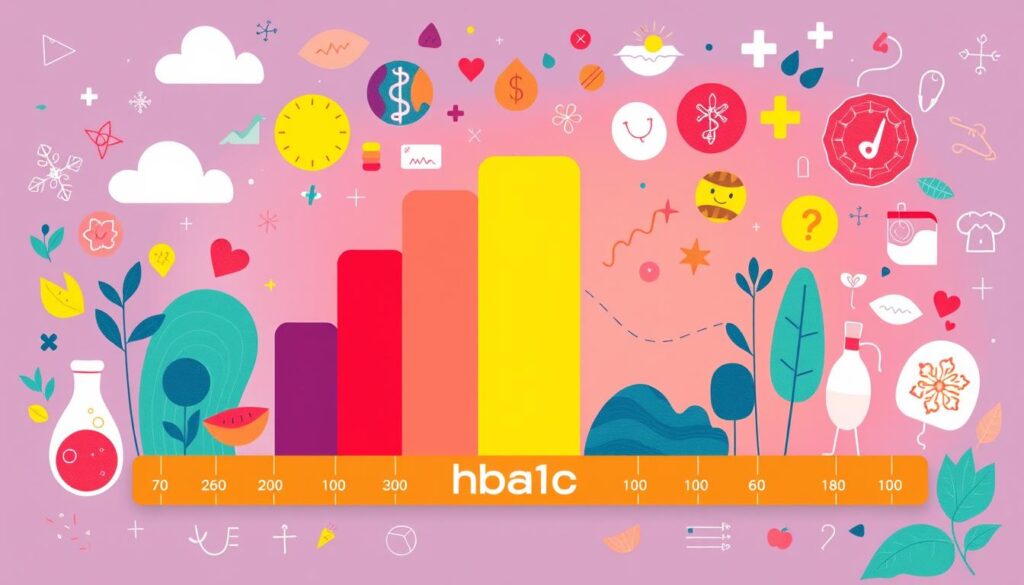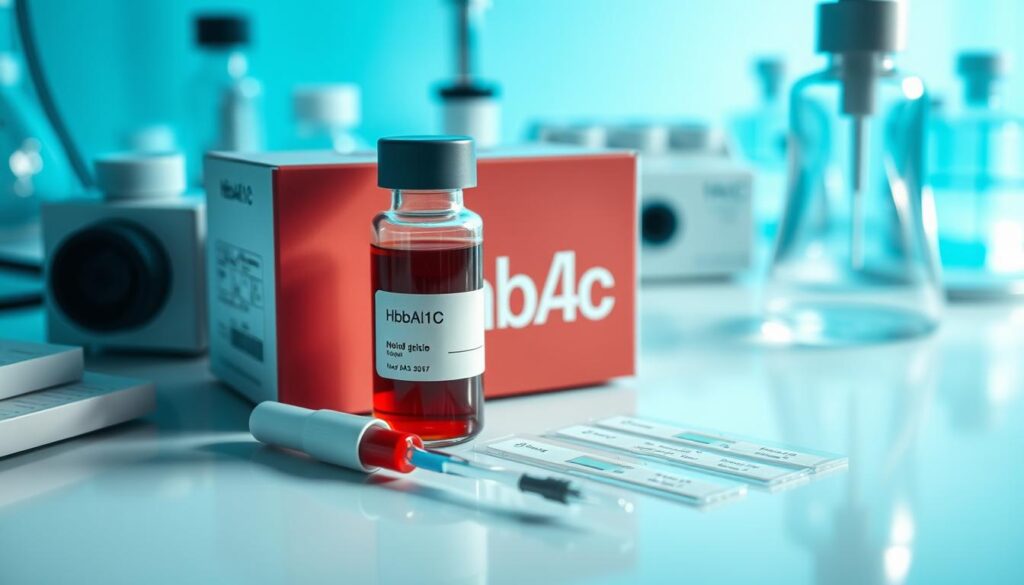Ever wondered how to better manage your blood sugar? The HbA1c test might hold the key. It’s a simple yet powerful tool for those with diabetes or at risk. But what is it, and why is it so important?

The HbA1c test shows your blood sugar levels over the past 2-3 months. It’s different from regular tests that only show a moment in time. This test helps doctors see how well you’re managing your diabetes and tailor treatments just for you. Learn about this important test and how it can help you manage your health.
What is HbA1c and Why It Matters
The HbA1c test, also known as glycated hemoglobin, shows how well you control your blood sugar over time. It measures glucose attached to hemoglobin in red blood cells over 2-3 months. Knowing your HbA1c levels helps you understand your blood sugar control and insulin resistance.
The Science Behind Glycated Hemoglobin
Hemoglobin carries oxygen in red blood cells. When glucose binds to it, it forms glycated hemoglobin or HbA1c. Higher blood glucose levels mean more glucose attaches to hemoglobin, raising your HbA1c value.
Key Differences Between HbA1c and Regular Blood Sugar Tests
- Regular blood sugar tests, like fasting glucose, show your blood sugar at a moment.
- The HbA1c test, however, shows your blood sugar average over 2-3 months, giving a broader view of your glucose management.
Role in Diabetes Diagnosis and Monitoring
The HbA1c test is key in diagnosing and managing diabetes. High HbA1c values suggest insulin resistance and uncontrolled blood sugar, signs of diabetes. Regular HbA1c tests help doctors check if your diabetes treatment is working and adjust it if needed.
| Metric | Description | Relevance |
|---|---|---|
| Glycated Hemoglobin (HbA1c) | Measures the average amount of glucose attached to hemoglobin in red blood cells over the past 2-3 months. | Provides a comprehensive assessment of long-term blood sugar control, which is crucial for managing and monitoring diabetes. |
| Fasting Blood Glucose | Measures the level of glucose in the blood after a period of fasting, typically 8-12 hours. | Helps diagnose diabetes and prediabetes, but only provides a snapshot of blood sugar at a specific time. |
| Random Blood Glucose | Measures the level of glucose in the blood at any given time, regardless of when the person last ate. | Useful for monitoring blood sugar fluctuations, but does not provide a complete picture of long-term glucose control. |
Normal HbA1c Ranges and Target Values
Knowing your is key for staying healthy, especially if you have diabetes or are at risk. The test shows your blood sugar levels over 2-3 months.
People without diabetes usually have between 4% and 5.6%. This means their blood sugar is well-managed and they face fewer diabetes risks. But, those with levels between 5.7% and 6.4% are at higher risk of getting type 2 diabetes.
For those with diabetes, the American Diabetes Association suggests these targets:
- General target: Less than 7%
- Younger adults (18-25 years): Less than 6.5%
- Older adults (65 years and above): Less than 8%
- Pregnant women: Less than 6%
Keeping your levels in these targets is crucial. It helps avoid diabetes complications like nerve damage and heart disease. Regular checks and managing your levels are vital for your health.

“Optimal levels are the key to reducing the risk of long-term complications associated with diabetes.”
How the HbA1c Test is Performed and Prepared For
The HbA1c test, or glycated hemoglobin test, is key for diabetes management. It shows your blood sugar levels over 2-3 months. Knowing how to prepare for and understand the HbA1c test helps you manage your diabetes better.
Test Preparation Guidelines
Before the HbA1c test, keep these tips in mind:
- No fasting is needed. You can get tested at any time, no matter when you last ate.
- Don’t change your diet or exercise too much before the test. It can affect your results.
- Tell your doctor about any medicines or supplements you’re taking. They can change your HbA1c levels.
Testing Procedure Explained
The test is a simple blood draw from your arm. The blood is then checked in a lab to see your blood sugar levels over 2-3 months.
Understanding Your Test Results
Your HbA1c result is a percentage, usually between 4% and 5.6%. People with diabetes aim for less than 7%, but your doctor might set a different goal for you.
Knowing your HbA1c results is key for controlling your glucose levels and diabetes management. Higher numbers mean a higher risk of diabetes problems. Lower numbers show better blood sugar control over time.

Managing and Improving Your HbA1c Results
Keeping your blood sugar in check is key for people with diabetes. By making lifestyle changes, eating right, and staying active, you can better your HbA1c scores.
Lifestyle Modifications for Better Control
Living a healthy lifestyle is the first step to managing your HbA1c. This means getting enough sleep, handling stress well, and checking your blood sugar often. These habits help control your blood sugar and lower the risk of diabetes problems.
Dietary Recommendations
Eating a balanced diet is important for managing your HbA1c. Eat lots of fruits, veggies, whole grains, and lean proteins. Try to avoid foods high in added sugars, refined carbs, and unhealthy fats. A dietitian can help you create a meal plan that keeps your blood sugar in check.
Exercise and Physical Activity Impact
Exercise is a big help in managing your HbA1c. Doing a mix of cardio, strength training, and flexibility exercises can lower your blood sugar and improve your heart health. Aim for 150 minutes of moderate exercise or 75 minutes of vigorous exercise a week. Always talk to your doctor before starting any new exercise routine.
FAQ
What is HbA1c and why is it important?
HbA1c, or glycated hemoglobin, is a blood test that shows your average blood sugar levels over 2-3 months. It’s key for checking long-term blood sugar control. It helps in diagnosing and managing diabetes.
How does the HbA1c test differ from regular blood sugar tests?
The HbA1c test looks at your blood sugar over time, unlike fingerstick tests that check current levels. It gives a broader view of your blood sugar management over months.
What are the normal HbA1c ranges and target values?
Non-diabetic people usually have HbA1c between 4% and 5.6%. Those with prediabetes have levels between 5.7% and 6.4%. People with diabetes aim for HbA1c under 7%, but targets can vary based on age, diabetes duration, and health.
How is the HbA1c test performed, and what should I do to prepare for it?
The HbA1c test is a simple blood draw from your arm’s vein. No special prep is needed, and you can have it done at any time. Your healthcare provider will guide you through the process.
How can I manage and improve my HbA1c results?
A healthy lifestyle, including a balanced diet, exercise, and weight control, can improve your HbA1c. Your doctor might suggest medication or insulin if needed. Regular checks and adjusting your diabetes plan can help reach your HbA1c goals.
